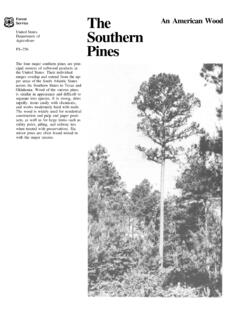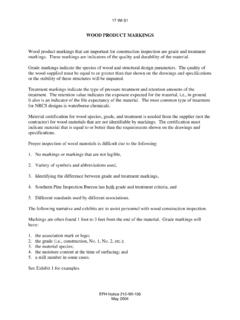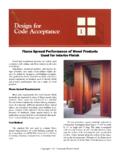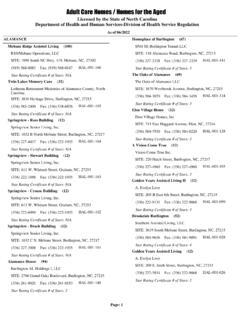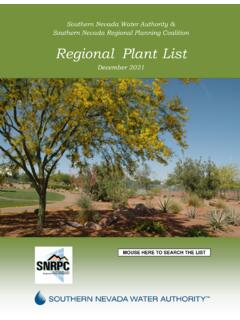Transcription of Familiar Trees of South Carolina - University of South ...
1 1 Bulletin 117 Familiar TreesFamiliar Treesof South Carolinaof South CarolinaA manual for tree studyA manual for tree 9 southern , , , Eastern , 12 Redcedar, , , , , , , , , 14 Catalpa, 17 Cherry, , 12 Elm, , , , , 18 Locust, , , , , 8 Oak, 7 The Clemson University Cooperative Extension Service offers its programs to people of all ages,regardless of race, color, sex, religion, national origin, or handicap and is an equal opportunity University Cooperating with Department of Agriculture, South Carolina Counties, Extension Service, B.
2 K. Webb, Director, Clemson, in Furtherance of Cooperative Extension Work in Agriculture and Home Economics, Acts of May 8 and June 30, 1914 CONTENTSPageIllustrations and Descriptions of of of to the More Common Trees of South and Twig TreesFamiliar Treesof South Carolinaof South CarolinaPrepared by George D. Kessler, Extension Forester and Professor of Forestry, andRoland E. Schoenike, Professor of ForestryTrees, one of the most conspicuous features of the South Carolina landscape, have played an importantrole in the history and the economic development of the Palmetto tree study manual has been prepared to aid 4-H Club members, teachers, youth group leaders,and others who want to identify or to know more about the Trees of our state.
3 It is a major revision of abulletin first issued in 1950. A total of 255,000 copies has been printed in the 17 editions issued to has endowed South Carolina with a wide variety and abundance of Trees . Although this manualdoes not include all the Trees found in the state, it is hoped that the 60 more important and commonones covered in this manual will help stimulate observation and arouse interest and appreciation oftrees-one of South Carolina s most important renewable natural interested in additional information on Trees may consult any of a number of books on treeidentification.
4 Some of these are listed below:Brockman, C. F. and Merrilees, R., Trees of North America, A Field Guide. New York: Golden , T. S., The Complete Trees of North America. New York: Van Nostrand Reinholt , William C., The Book of Trees . Stackpole Company, Box 1831, Harrisburg, PA 17105 Little, Elbert, The Audubon Society Field Guide for North American Trees . New York: A. A. , G. A., A Field Guide to Trees and Shrubs. Boston, Mass.: Houghton, Mifflin , R. J., North American Trees . Ames, Iowa: Iowa State University PinePinus taedaLongleaf PinePinus palustrisThis fast-growing pine produces abundant seeds; reseedsabandoned fields.
5 Because of its wide range, abundance, andversatility, loblolly pine is the principal commercial pinespecies in the Southeastern United the early days of our colonies, longleaf pine has been aprime source of lumber and naval stores (turpentine, tar,pitch, rosin). Has the longest needles of any pine in SouthCarolina 8 to 20 inches PinePinus echinataNeedles in clusters of 2's, rarely 3's or 4's. The abundantcones are among the smallest of those of our southern pines 1 to 2 inches long, generally clustered, often remainon the twigs for 3 or 4 PinePinus elliottiiAlong with longleaf, slash pine yields naval stores.
6 Widelyplanted throughout the Coastal Plain and Sandhills. Thescientific name honors noted S. C. botanist Stephen Elliott,who in 1824 first described it as a variety of loblolly PinePinus serotinaVirginia PinePinus virginianaGrows on low, wet flats, usually in lowlands of the CoastalPlain. The short, broad, top-shaped cones persist unopenedon the branches for , gray-green needles 1 to 3 inches long in bundles of 2,often twisted. Cones with sharp prickles. Old, open conesremain on the branches for several years. Capable of growingon eroded and poorly drained PinePinus glabraFound on damp coastal sites.
7 Bark and foliage resemblewhite pine . Also known as Walter pine , honoring S. Thomas Walter, who published the first descriptionof the tree in 1788 in his Flora White PinePinus strobusSoft, flexible, bluish-green needles, only native pine in theEast with 5 needles. The King's Broad Arrow, used to markwhite pine Trees reserved as shipmasts for the Royal Navy,helped to stir New England colonists to distichumCabbage PalmettoSabal palmettoFunction of the cypress knees is not definitely may live for over 1,000 years.
8 Wood is durable. Onlynative southern conifer which sheds its leaves each Carolina 's official state tree, it appears on the stateflag and the state seal and gives the state its nickname of the Palmetto State. Blossoms are excellent sources of nectarfrom which bees make RedcedarJuniperus virginianaThe reddish, aromatic heartwood is used for making cedarchests and closet linings. Once the principal species used tomake wooden casings for lead pencils. Heartwood durable,used for fenceposts. A favorite Christmas HemlockTsuga canadensisEvergreen thickets of young hemlock provide excellent coverfor wildlife.
9 Can be sheared easily and is sometimes used asa hedge plant. Tolerant of shade and slow in OakQuercus albaPost OakQuercus stellataOne of our largest and most valuable Trees . Sometimesattains an age of 600 years or more. High-grade all-purposewood especially suitable for furniture, flooring, and leaves, cross-shaped in outline. Wood used forcrossties and fence posts. Slow-growing, long-lived. Goodacorn crop every 2 or 3 years. A preferred food of turkey OakQuercus virginianaNow prized as a shade or ornamental tree.
10 In the days ofsailing ships it provided timbers for their construction, andthe U. S. set aside several land preserves of the tree for theexclusive use of the Chestnut OakQuercus michauxiiThe leaves turn a rich crimson color in the fall. Wood usedfor making baskets. Often known as basket oak or cow ; wood OakQuercus lyrataChestnut OakQuercus prinusThe name of the tree comes from the acorn being almostentirely enclosed in the nearly spherical cup. Often calledswamp white oak or swamp post oak. Nowhere on poorly drained soils, slow growing, long , hard, strong, tough, close-grained wood which isdurable in the soil.

